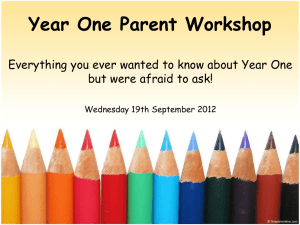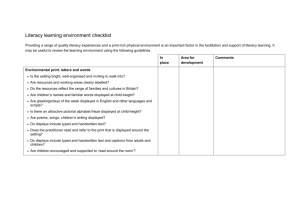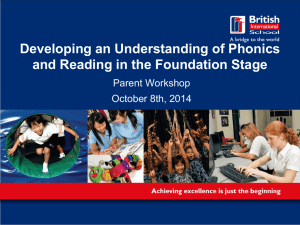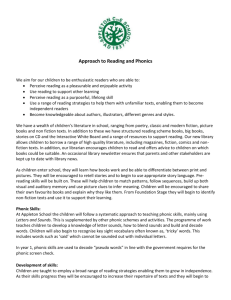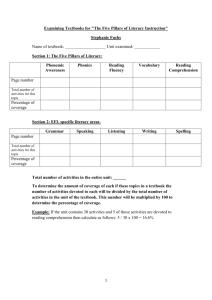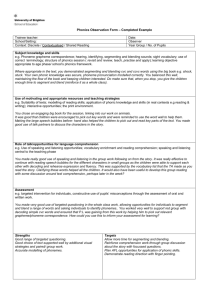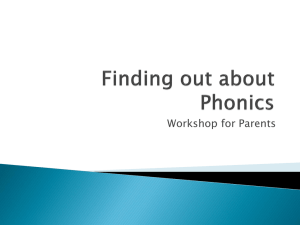Phonics & Early Reading Overview: Guidance for Educators
advertisement
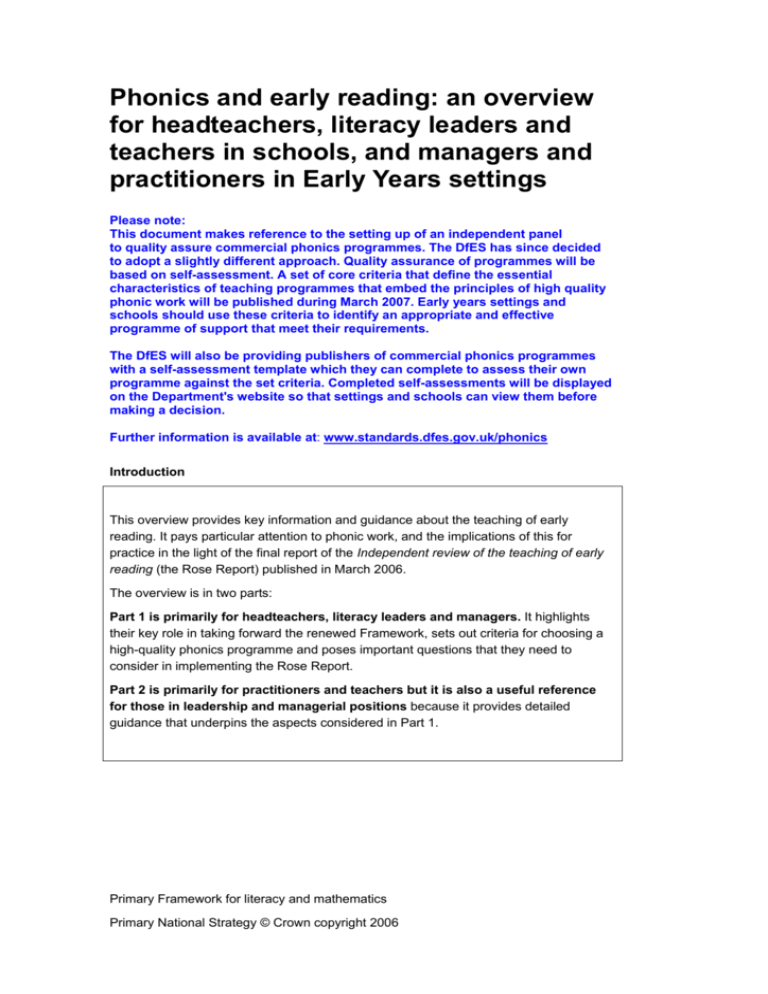
Phonics and early reading: an overview for headteachers, literacy leaders and teachers in schools, and managers and practitioners in Early Years settings Please note: This document makes reference to the setting up of an independent panel to quality assure commercial phonics programmes. The DfES has since decided to adopt a slightly different approach. Quality assurance of programmes will be based on self-assessment. A set of core criteria that define the essential characteristics of teaching programmes that embed the principles of high quality phonic work will be published during March 2007. Early years settings and schools should use these criteria to identify an appropriate and effective programme of support that meet their requirements. The DfES will also be providing publishers of commercial phonics programmes with a self-assessment template which they can complete to assess their own programme against the set criteria. Completed self-assessments will be displayed on the Department's website so that settings and schools can view them before making a decision. Further information is available at: www.standards.dfes.gov.uk/phonics Introduction This overview provides key information and guidance about the teaching of early reading. It pays particular attention to phonic work, and the implications of this for practice in the light of the final report of the Independent review of the teaching of early reading (the Rose Report) published in March 2006. The overview is in two parts: Part 1 is primarily for headteachers, literacy leaders and managers. It highlights their key role in taking forward the renewed Framework, sets out criteria for choosing a high-quality phonics programme and poses important questions that they need to consider in implementing the Rose Report. Part 2 is primarily for practitioners and teachers but it is also a useful reference for those in leadership and managerial positions because it provides detailed guidance that underpins the aspects considered in Part 1. Primary Framework for literacy and mathematics Primary National Strategy © Crown copyright 2006 Part 1: guidance for headteachers, literacy leaders and managers The 'simple view of reading' The Rose Report makes a number of recommendations for the teaching of early reading and for replacing the ‘Searchlights’ model, used in the original literacy framework. It makes clear that there are two dimensions to reading – ‘word recognition’ and ‘language comprehension’. These two dimensions are represented in a new conceptual framework – the ‘simple view of reading’ (see The new conceptual framework for teaching reading: the simple view of reading – overview for literacy leaders and managers in schools and early years settings) – as word recognition processes and language comprehension processes. Figure 1: The simple view of reading Primary Framework for literacy and mathematics Primary National Strategy © Crown copyright 2006 The processes by which children comprehend spoken language are the same as those by which they comprehend the words on the page; the difference being that the first relies upon hearing the words and the second upon seeing the words in written form. Obviously, in order to comprehend written texts children must first learn to recognise, that is decode, the words on the page. The report notes that when children begin to learn to read they have already made considerable progress in their language development. Unlike early language acquisition, the subsequent, time-limited task that is word reading is ‘generally achieved as a result of direct instruction’. High-quality phonic teaching, therefore, secures the crucial skills of word recognition that, once mastered, enable children to read fluently and automatically thus freeing them to concentrate on the meaning of the text. In other words, the learning of phonic skills for reading is a time-limited process whereas ‘developing the abilities necessary to understanding and appreciating written texts in different content areas and literary genres continues throughout the lifespan’. The ‘simple view of reading’ shows that both dimensions are necessary to achieve fluent reading. However, the balance between word recognition and language comprehension shifts as children acquire secure and automatic decoding skills and progress from ‘learning to read’ to ‘reading to learn’ for purpose and pleasure. The ultimate goal of learning to read is comprehension. To achieve this, practitioners and teachers need to be clear about which activities are designed to teach children to acquire word recognition skills, and which will help children develop high-level comprehension skills. Principles of high-quality phonic work The Rose Report makes clear that ‘high-quality phonic work’ should be taught systematically and discretely as the prime approach used in the teaching of early reading. This means that settings and schools should put in place a discrete programme as the key means for teaching phonics. Importantly, the report makes clear that high-quality phonic work is not a ‘strategy’ so much as a body of knowledge, skills and understanding that has to be learned. Beginner readers should be taught: • grapheme–phoneme correspondences in a clearly defined, incremental sequence • to apply the highly important skill of blending (synthesising) phonemes in the order in which they occur, all through a word to read it • to apply the skills of segmenting words into their constituent phonemes to spell • that blending and segmenting are reversible processes. The report recommends that high-quality phonic work will be most effective when: Primary Framework for literacy and mathematics Primary National Strategy © Crown copyright 2006 • it is part of a broad and rich curriculum that engages children in a range of activities and experiences to develop their speaking and listening skills and phonological awareness • for most children it starts by the age of 5, subject to the professional judgement of teachers and practitioners • it is multisensory, encompassing simultaneous visual, auditory and kinaesthetic activities to enliven core learning • it is time-limited, such that the great majority of children should be confident readers by the end of Key Stage 1 • it is systematic, that is to say, it follows a carefully planned programme with fidelity, reinforcing and building on previous learning to secure children’s progress • it is taught discretely and daily at a brisk pace • there are opportunities to reinforce and apply acquired phonic knowledge and skills across the curriculum and in such activities as shared and guided reading • children’s progress in developing and applying their phonic knowledge is carefully assessed and monitored. Assessment The Rose Report emphasises the importance of phonics as the prime approach to teaching word recognition for the vast majority of children, including those with English as an additional language. Moreover, high-quality phonic teaching, following the principles above, can substantially reduce the number of children who fall below agerelated expectations. This focus on quality-first teaching should reduce the need for intervention in many cases. To achieve these ends, a robust and continuous assessment of children’s phonic progress is needed to identify those with additional needs, including those with specific learning difficulties. These children will require immediate and sustained additional support to close the gap with their peers. For a very small minority of children with special educational needs such as neurodevelopmental disorders there are considerable obstacles to learning to read and write. To support such children, settings and schools should make full use of the specialist guidance and support that is available. What headteachers and leaders of settings need to do to secure high-quality teaching and learning of phonic work Headteachers and leaders have a responsibility to audit practice and provision for reading in their schools and settings to make sure that: • a high-quality, systematic phonics programme is in place for most children by the age of 5, subject to professional judgement (this will mean selecting and implementing a programme that meets the criteria set out below in ‘Choosing a programme for the teaching of phonics’) Primary Framework for literacy and mathematics Primary National Strategy © Crown copyright 2006 • phonic work is given appropriate priority in the teaching of beginner readers and this is reflected in decisions about training and professional development for their staff so that teachers and practitioners have the necessary skills and knowledge to implement the programme effectively • at least one member of staff is fully able to lead on literacy, especially phonic work • the normal monitoring arrangements assure the quality and consistency of phonic work and that staff receive constructive feedback about their practice • high-quality teaching and learning of reading and writing in Key Stage 1 informs realistic and ambitious target-setting for English at Key Stage 2 • parents and carers are informed about the approach to reading and how they can support it Choosing a programme for the teaching of phonics High-quality phonic work can be achieved by using a commercially produced programme, or Primary National Strategy materials. Settings and schools can also use other programmes such as those they have developed themselves, or which have been developed for use within their local area. What is important is that the programme adopted by the school or setting meets the criteria for high-quality phonic work and that it is adhered to ‘with fidelity’, applied consistently and used regularly, avoiding drawing in too many elements from different programmes. The following criteria should therefore be applied by schools and settings in choosing a high-quality programme or when judging the quality of their existing programme for teaching phonics. The programme must: • be fully compatible with a broad and rich curriculum • be systematic, with a clearly defined and structured progression for learning all the major grapheme–phoneme correspondences: digraphs, trigraphs, adjacent consonants, and alternative graphemes for the same sound • be delivered in discrete daily sessions at a brisk pace that is well matched to children’s developing abilities • be underpinned by a synthetic approach to blending phonemes in order all through a word to read it, and segmenting words into their constituent phonemes to spell them • make clear that blending and segmenting are reversible processes • be multisensory, encompassing various visual, auditory and kinaesthetic activities that actively engage children (e.g. manipulating magnetic or other solid letters to build words, or activities involving physical movement to copy letter shapes) • make clear the importance of speaking and listening as the foundation for embarking on a systematic phonics programme and for acquiring the skills of reading and writing • offer clear guidance on how to assess progress and use this to inform the next steps of learning • offer guidance about adapting and adjusting the programme for children with special educational needs or who have missed earlier elements. Primary Framework for literacy and mathematics Primary National Strategy © Crown copyright 2006 To assist settings and schools in choosing a phonics programme, the DfES plans to set up an independent quality assurance system to assess commercial phonics programmes. This system will evaluate these programmes, based on the criteria set out above. We will publish a list of programmes that meet the criteria on the DfES website during the spring term 2007. The Department and the Primary National Strategy will also use independent experts to develop a new phonics programme that meets these same criteria to replace ‘Playing with sounds: a supplement to progression in phonics’, which will also be available during the spring term 2007. This will make it easier for settings and schools to implement high-quality phonics teaching, either by choosing a commercial programme, by using the new Primary National Strategy phonics programme, or by using programmes that they have developed themselves, which meet these criteria. Questions for headteachers and leaders of settings to consider in light of the principles and recommendations of the Rose Report • How do we currently teach word recognition skills? • How effective are we at teaching these skills and how do we know this? • What will need to change? • How do we currently teach comprehension skills? • How effective are we at teaching these skills and how do we know this? • What will need to change? • How will we set about reviewing our policy on reading and the impact of our teaching of reading? • How will we know that the changes we make are having the desired impact on learning and teaching and on children’s reading attainment? How the renewed Framework will support schools and settings in implementing the recommendations on the teaching of early reading To support headteachers and managers of schools and settings, and practitioners, in implementing the recommendations of the Rose Report, the renewed Framework and its related guidance are designed to do the following. • Make clear the distinction between the two dimensions of reading identified in the new conceptual framework – the ‘simple view of reading’. This is done by, for example, grouping learning objectives related to word recognition under one strand (Strand 5: Word recognition: decoding (reading) and encoding (spelling)) and those related to comprehension under two other strands (Strand 7: Understanding and interpreting texts and Strand 8: Engaging with and responding to texts). • Give a greater emphasis to speaking and listening and the interdependent nature of speaking and listening, and reading and writing and how these are developed. There is support on making explicit links across all these four strands within and across a series of teaching sessions. These materials, which include planning exemplars to support high-quality teaching of phonic work, can be accessed through the literacy tab of the online framework and through the Early Years Foundation Stage tab. Primary Framework for literacy and mathematics Primary National Strategy © Crown copyright 2006 • Give support on integrated planning across all aspects of literacy through the literacy tab. Professional development to support schools and settings in implementing the recommendations of the Rose Report The renewed Framework is accompanied by a range of professional development opportunities to enable schools and settings to meet the recommendations of the Rose Report. The Primary National Strategy will provide local authorities, settings and schools with materials and guidance to support continuing professional development (CPD) to improve the teaching of early reading. These materials will include guidance to help settings and schools audit their current provision for the teaching of early reading. A description of the CPD materials and guidance can be found in Supporting Guidance for Headteachers and Chairs of Governors (ref: 02009-2006PCK-EN and DVD 02009DVD-EN). Part 2: A sequence for teaching high-quality phonic work for practitioners and teachers, and underpinning guidance The sounds of English British spoken English is generally reckoned to use 44 sounds, or ‘phonemes’. Technically, a phoneme is the smallest unit of sound that can make a difference to the meaning of a word. Twenty of these are vowel sounds and 24 are consonant sounds. Many of the sounds (particularly vowel sounds) can vary slightly according to accent, but they are generally consistent within the speech of an individual and recognisable by others who may pronounce them slightly differently. Alphabetic writing Alphabetic writing is based on the principle that letters and groups of letters (graphemes) represent the small units of sound (phonemes) in spoken words: that is to say, the letters are a written code for the speech sounds. In reading, the sounds are produced in response to single letters and letter-groups of from two to four letters (e.g. ‘sh’, ‘igh’, ‘eigh’) and then have to be blended together. In spelling, the whole spoken word has to be segmented (split up) into separate sounds so that letters and letter-groups can be written down to represent the sounds. Some languages have very simple alphabetic codes where each letter or letter-group always stands for the same sound, and each sound is represented in only one way in writing. English, however, has a complex alphabetic code. Most sounds can be represented in more than one way in writing (e.g. the /s/ sound can be written with the letter ‘s’, as in ‘sit’, with ‘ss’, as in ‘fuss’, and with ‘c’ as in ‘city’), and most letters and Primary Framework for literacy and mathematics Primary National Strategy © Crown copyright 2006 letter-groups can represent more than one sound (e.g. the letter ‘c’ can represent both the /k/ sound, as in ‘cat’, and the /s/ sound, as in ‘city’). Sequential stages Obviously, it makes sense to start beginner readers at a simple level before introducing the complexities. This is best achieved by staging the work in an incremental sequence as follows. Introducing grapheme–phoneme correspondences Children should be taught the 26 letters of the alphabet and a sound for each letter. (Strictly speaking, the sounds that we associate with the letters ‘q’ and ‘x’ are each two sounds: /kw/ for ‘q(u)’ and /ks/ or /gz/ (as in ‘fox’ and ‘exam’) for ‘x’. For the purpose of teaching beginners, however, it is sensible to treat each of these as a single sound.) They should be taught to write each letter, forming it correctly. Children should be taught to produce the sounds as purely as possible – that is, not to add /uh/ (‘schwa’) sounds, particularly after consonants such as /b/, /d/, /g/. Once correspondences have been taught, they should be frequently revised and practised so that responses are automatic. Sounds should be produced quickly in response to letters, and letters should be pointed to or written quickly in response to sounds. The reversible nature of decoding for reading and encoding for spelling should be reinforced from the earliest stages. Vowels and consonants should both be taught from the start, and in an order that allows children to start reading and spelling simple words as soon as the first few correspondences have been taught. They read by producing sounds for letters and blending the sounds, and they spell by the reverse process of segmenting the spoken word into sounds and writing down appropriate letters. Blending and segmenting need to be taught explicitly. Some skill is involved in converting the staccato sounds produced in response to letters into seamless word-pronunciations and in splitting up seamless spoken words into individual sounds. Plenty of practice should be given in reading and writing words containing all the correspondences that have been taught. This allows children to consolidate both their knowledge of the correspondences and their blending and segmenting skills. Reading and spelling simple regular words The skills of blending and segmenting CVC words are easily adapted to words containing consecutive consonants in CCVC and CVCC words (such as ‘spit’ and ‘mint’) and then to more complex words (such as ‘split’ or ‘crust’). This is an important phase for widening the words available to children for reading. Introducing sounds that are represented by more than one letter Sounds that can be represented only by letter-groups (mostly digraphs, at this stage) should be taught: ‘sh’, ‘ch’, ‘th’ (these can represent two sounds, one ‘voiced’ and one ‘unvoiced’, as in ‘thin’ and ‘then’), ‘ng’ (‘sing’), ‘ee’, ‘ay’, ‘ie’ (‘pie’), ‘oa’ (‘boat’), ‘oo’ (two sounds, as in ‘moon’ and ‘book’), ’or’ (‘port’), ‘ar’ (‘car’), ‘er’ (‘fern’), ‘ow’ (‘town’), ‘oy’ Primary Framework for literacy and mathematics Primary National Strategy © Crown copyright 2006 (‘boy’), ‘air’, ‘ear’. Again, children should be given practice in reading and writing words containing these correspondences as they are taught. Introducing alternative grapheme–phoneme correspondences Alternative sounds for spellings already covered should be taught. Such examples include the /s/ sound of ‘c’ (‘city’), the /j/ sound of ‘g’ (‘gem’) and the /o/ sound of ‘a’. This can often be covered during the teaching of high frequency words: for example, ‘was’ and ‘want’ illustrate the /o/ sound which ‘a’ tends to have after a /w/ sound. Alternative spellings for the sounds already covered should also be taught. Examples would include ‘ea’ for the already-taught /ee/ sound, ‘oe’ for the already-taught /oa/ sound and ‘igh’ for the already-taught /ie/ sound. Introducing ‘tricky’ words Once children are starting to blend CVC words, high frequency words that do not follow the letter-sound correspondences taught can be introduced. This may be done at the rate of two or three per week but the professional judgement of the pace must lie with the teacher or practitioner. Examples of such words include ‘the’, ‘was’, ‘said’, ‘once’. Even these words usually contain some common letter–sound correspondences, and children should have their attention drawn to these so that they do not regard the words as completely random. This can be combined with the teaching of the few sounds that have not yet been covered because they are less straightforward in terms of their spelling. Children’s attention can be drawn to such words in shared reading and writing sessions to increase their exposure to them. Implications of high-quality phonic work for shared and guided reading Part 1 of this overview explained that schools and settings should put in place a systematic, discrete programme as the key means for teaching high-quality phonic work. Shared and guided reading sessions should not be used to replace discrete phonics teaching but they can provide opportunities to reinforce children’s developing phonic knowledge and skills, in the context of achieving the ultimate goal of the sessions, which is the development of comprehension. Guidance is given below. Shared reading Shared reading has a number of specific functions in the teaching of early reading: • inducting children into the world of literature, meaning and response • providing rich opportunities for increasing children's stock of words and teaching early reading behaviours • serving as a vehicle for extending children’s understanding of what is being read, that is their language comprehension • providing opportunities to apply acquired decoding skills in context, reinforcing children’s developing phonic knowledge and skills gained from discrete, daily phonic sessions Primary Framework for literacy and mathematics Primary National Strategy © Crown copyright 2006 When engaging children in shared reading, teachers need to be clear which aspect of reading they are addressing. They will need to consider carefully the purpose of each session, the relevant learning objectives and the opportunities the selected text provides to support this work. Discussion of the text also offers opportunities to underpin other aspects of the curriculum such as personal, social and emotional development. Reinforcing decoding skills (see the principles of high-quality phonic work described on page three) If the purpose of the shared session is to encourage children to apply acquired phonic skills, then their attention should be focused on decoding words rather than the use of unreliable strategies such as looking at the illustrations, rereading the sentence, saying the first sound or guessing what might ‘fit’. Although these strategies might result in intelligent guesses, none of them is sufficiently reliable and they can hinder the acquisition and application of phonic knowledge and skills, prolonging the word recognition process and lessening children’s overall understanding. Children who routinely adopt alternative cues for reading unknown words, instead of learning to decode them, later find themselves stranded when texts become more demanding and meanings less predictable. The best route for children to become fluent and independent readers lies in securing phonics as the prime approach to decoding unfamiliar words. In order to reinforce decoding in shared reading, practitioners and teachers should adhere to letters and sounds already taught so that children experience how to apply their knowledge in the context of reading texts. Words, phrases and/or even whole sentences from a Big Book or other enlarged texts can be used to demonstrate this skill, as well as exploiting opportunities in the environment such as words in labels, captions and displays. Developing comprehension (see also separate document on Comprehension) When children learn to read, the comprehension processes they use to understand written texts are the same as those they already use to understand spoken messages. The main difference is that the language of written text is accessed via the eyes rather than the ears. Independent review of the teaching of early reading (the Rose Report), Appendix 1, paragraph 62, page 90 If the focus for the session is the development of comprehension, then practitioners should concentrate on plot, character, and motive, and features of language such as vocabulary, figurative language and sequence. Children benefit if they can make links to their previous experience, or they are supported where the text deals with matters that are beyond their immediate experience. Over time, the practitioner will model how readers predict, question, clarify, summarise and imagine as they read; and in time, children should internalise these mental activities. Modelling one or two strategies really well is preferable to overloading children with multiple approaches. Primary Framework for literacy and mathematics Primary National Strategy © Crown copyright 2006 Guided reading Guided reading is a carefully structured session in which a small number of children are helped to apply their freshly learned skills in context. It is tailored to the specific needs and ability of the individual, or a group of individuals working at the same level. In the session, the teacher guides the children through a text, prompting them to apply the knowledge and skills they have learned elsewhere in the reading curriculum. The aim is to encourage and extend independent reading skills on new and increasingly challenging texts. Children gain most from guided reading when they have already developed a sound understanding about how texts work, about the alphabetic code, and when they have considerable experience of listening to and talking about texts. Guided reading sessions offer a good opportunity for children to practise their developing phonic knowledge skills in texts that are carefully chosen to match their abilities. Where the focus is on honing phonic skills, the practitioner’s role is to support and prompt children to decode, recognise and say words as they read, thus helping them to access the meaning of the text. The success of the guided reading session depends on the teacher being clear about the purpose of the session and its specific learning objectives. Early on, new readers will be focused on the application of phonic skills and word recognition, but as they grow in confidence and skill, the emphasis will shift to comprehension. The practitioner makes an important decision at the planning stage about the focus of the session, and this decision is largely determined by close observation of what the children know, understand and can do. Guided reading sessions should be pitched carefully to the level and needs of the children in the session at the time. This implies a high level of knowledge about the exact state of each child’s phonic learning. This is achieved through observation, robust assessment and regular contact during phonic sessions. In deciding what to teach in guided reading sessions, teachers might start by considering the four types of reader identified in the ‘simple view of reading’: • those who have good comprehension but poor word recognition skills • those who have good word recognition skills but poor comprehension • those who are weak in both the above • those who are strong in both the above Clearly, the child who has good levels of comprehension but weak word recognition needs to consolidate their phonic knowledge and to apply that knowledge in practice. Conversely, children with strong word recognition skills but poor comprehension need to be focused on meaning. The choice of text for the guided reading session is particularly important. The text should be within the child’s current capabilities in order to exercise the new skills without becoming frustrated. The text must also be carefully chosen to appeal to a child’s age, Primary Framework for literacy and mathematics Primary National Strategy © Crown copyright 2006 ability, interests and circumstances. For example, a child who is new to English may be able to decode quickly, but limited familiarity with English vocabulary may limit his or her immediate comprehension. Guided reading is a wonderful opportunity for teachers and learners to engage with texts in the most personalised way. It deserves the best possible planning for the best possible return on the investment of precious time. Primary Framework for literacy and mathematics Primary National Strategy © Crown copyright 2006



